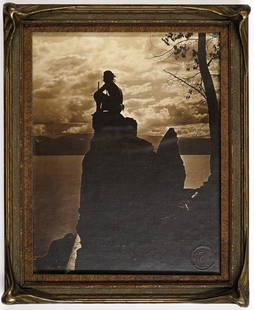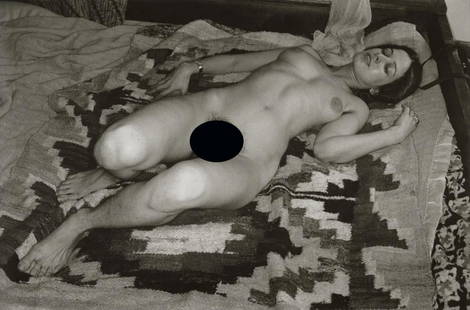Popular Searches
Popular Searches

Flathead, Montana Native Americans, 1900
Similar Sale History
View More Items in Photography![[NATIVE AMERICANS]. REED, Roland W. (1864-1934), photographer. The Pottery Maker. 1913.: [NATIVE AMERICANS]. REED, Roland W. (1864-1934), photographer. The Pottery Maker. 1913.13 1/2 x 10 1/2 in. silver gelatin photograph (soiling and residue to verso, some edge and corner wear). Copyrigh](https://p1.liveauctioneers.com/197/309287/165439044_1_x.jpg?height=310&quality=70&version=1699649440)
![[NATIVE AMERICANS]. CURTIS, Edward (1868-1952), photographer. The Invocation. 1907. : [NATIVE AMERICANS]. CURTIS, Edward (1868-1952), photographer. The Invocation. 1907. 5 3/4 x 8 in. platinum photograph on original mount, matted and framed, 16 x 19 1/4 in. (even toning to print,](https://p1.liveauctioneers.com/197/265299/138516465_1_x.jpg?height=310&quality=70&version=1666051328)
Related Photography
More Items in Photography
View MoreRecommended Art
View More




Item Details
Description
Age: C. 1900
Size: 4.62x5.75"
Weight: 1.0oz
Maker: Unknown
Frame/Mat Size: 6.5x5.5"
Frame Description: Cardboard
Provenance: Connecticut Estate
Description: This photograph is of a pair of Native Americans from the Flathead Reservation in Montana, holding up a board that their child is affixed to. The man holds a circular hat, taken off for the purposes of the photo. The woman has her hair covered by a shawl and holds her jacket closed over her body. A wooded forest makes for a backdrop.
Condition: The bottom left of this photograph has become heavily washed out, making it a white blur. Other than that, there is no physical damage.
History: Native Americans have lived in Montana for more than 14,000 years, based on archaeological findings. The Bitteroot Salish came from the West Coast, whereas the Kootenai lived mostly in the interior of present-day Idaho, Montana, and Canada. The Kootenai left artifacts in prehistoric time. One group of the Kootenai in the northeast lived mainly on buffalo hunting. Another group lived on the rivers and lakes of the mountains in the west. When they moved east, they could rely less on salmon fishing, but turned to eating plants and buffalo. During the 18th century, the Salish and the Kootenai tribes shared gathering and hunting grounds. As European-American settlers entered the area, the peoples came into conflict.In 1855 the United States (US) made the Treaty of Hellgate, by which it set aside a reservation solely for the Flathead. Although the tribe opposed European-style allotments and farming, the US Congress passed the 1904 Flathead Allotment Act. After allotments of land to individual households of members on the tribal rolls, the government declared the rest "surplus" and opened the reservation to homesteading by whites. United States Senator Joseph M. Dixon of Montana played a key role in getting this legislation passed. Its passage caused much resentment by the Flathead, and the allotment of reservation lands remains "a very sensitive issue". The Flathead would like to regain control of their reservation lands.The area was favorably compared to the Yakima River Valley in Washington State. Thousands of acres on the reservation were reserved for town sites, schools and the National Bison Range. The Flathead were given first choice of either 80 or 160 acres of land per household. The rest was made open to whites in 1910. A total of 81,363 applications by whites were received for 1,600 parcels of land. The applications were placed in plain brown envelopes, piled onto a pallet, and three young girls drew 6,000 of them, choosing who would have a chance to homestead on the land. The first 3,000 were notified in the spring and the second 3,000 were notified in the fall. But, lottery winners took only 600 tracts, leaving 1,000 tracts still open. These were taken in what the tribe considers a subsequent "land grab". According to their treaty, the tribes have the right to off-reservation hunting, but the state believed it could regulate those activities. State game wardens were responsible for the confrontation that led to four deaths, what is known as the Swan Valley Massacre of 1908
Buyer's Premium
- 24.5%
Flathead, Montana Native Americans, 1900
Estimate $50 - $100
3 bidders are watching this item.
Shipping & Pickup Options
Item located in Garrison, NY, usSee Policy for Shipping
Payment

Related Searches
TOP






















![T. J. Hileman (2) Photogravures [Native American]: T. J. (Tomar Jacob) Hileman (American, 1882-1945) was a historic photographer documenting the landscapes and Native American tribes of Glacier National Park, Montana. Subjects of the two (2) photograv](https://p1.liveauctioneers.com/5755/301438/160650912_1_x.jpg?height=310&quality=70&version=1694035720)




![[NATIVE AMERICANS]. HELLER, Louis Herman (1839-1928), photographer. A group of 12 photographs of: [NATIVE AMERICANS]. HELLER, Louis Herman (1839-1928), photographer. A group of 12 photographs of Modoc Indian prisoners. San Francisco, CA: Carleton Watkins, 1873. 2 7/8 x 4 in. albumen photogra](https://p1.liveauctioneers.com/197/250551/130130190_1_x.jpg?height=310&quality=70&version=1654185975)
![[NATIVE AMERICANS]. FLY, C.S. (1849-1901), photographer. Geronimo, the Apache Chief, as taken before: [NATIVE AMERICANS]. FLY, C.S. (1849-1901), photographer. Geronimo, the Apache Chief, as taken before the surrender to Gen. Crook in the Sierra Madre mountains of Mexico. Tombstone, AZ, 1888.4 7/8 x 7](https://p1.liveauctioneers.com/197/309287/165439034_1_x.jpg?height=310&quality=70&version=1699649440)
![[NATIVE AMERICANS]. GARDNER, Alexander (1821-1882), photographer. Cabinet card featuring Red Cloud.: [NATIVE AMERICANS]. GARDNER, Alexander (1821-1882), photographer. Cabinet card featuring Red Cloud. Washington, DC: 1872. 4 1/16 x 6 in. albumen photograph on cardstock mount (spots of discolora](https://p1.liveauctioneers.com/197/250551/130130147_1_x.jpg?height=310&quality=70&version=1654185975)
![[NATIVE AMERICANS]. SOULE, William S. (1836-1908), photographer. A group of 2 cabinet cards of: [NATIVE AMERICANS]. SOULE, William S. (1836-1908), photographer. A group of 2 cabinet cards of Comanche subjects. Fort Sill, Indian Territory: ca 1867-1870s. 4 x 6 in. cabinet cards, or smaller](https://p1.liveauctioneers.com/197/250551/130130157_1_x.jpg?height=310&quality=70&version=1654185975)
![[NATIVE AMERICANS]. DE GRAFF, W.H., photographer.: [NATIVE AMERICANS]. DE GRAFF, W.H., photographer. Cabinet card of Sitting Bull. Bismarck, North Dakota: ca 1890s. 3 7/8 x 5 1/4 in. cabinet card on cardstock mount (rich tonality, even toning; light e](https://p1.liveauctioneers.com/197/224021/115492084_1_x.jpg?height=310&quality=70&version=1635379320)
![[NATIVE AMERICANS] -- [WESTERN AMERICANA & CANADA]. Album containing photographs of Native American: [NATIVE AMERICANS] -- [WESTERN AMERICANA & CANADA]. Album containing photographs of Native American subjects and scenic views of the Western United States and Canada. Ca 1910s. Horizontal folio](https://p1.liveauctioneers.com/197/250551/130130235_1_x.jpg?height=310&quality=70&version=1654185975)


![[NATIVE AMERICANS]. [GERONIMO (1829-1909)]. Boudoir cabinet...: [NATIVE AMERICANS]. [GERONIMO (1829-1909)]. Boudoir cabinet photograph. Washington, D.C.: A.F. Randall, 16 May 1884. On original studio mount (216 x 133 mm), photographer rubberstamp on verso, also wi](https://p1.liveauctioneers.com/928/323637/174189192_1_x.jpg?height=310&quality=70&version=1711128397)

























![[Custer, Little Big Horn] Eagle Elk, Oglala Sioux Warrior: “I was about 25 the summer we fought Long Hair and I still believed we could drive the white men from our country. I’m a little sad yet about that fight, although it was our finest victory.”](https://p1.liveauctioneers.com/7226/322253/173251540_1_x.jpg?height=310&quality=70&version=1710004847)
















